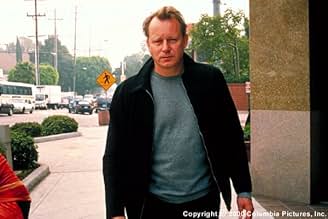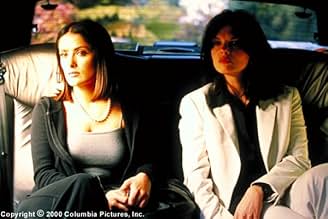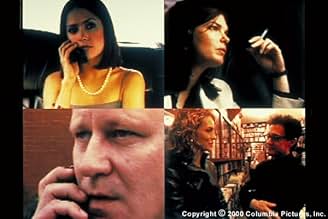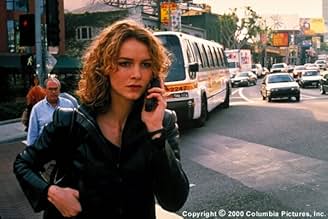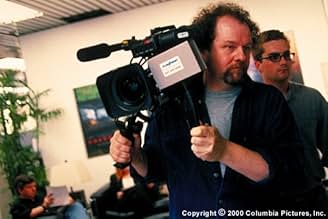CALIFICACIÓN DE IMDb
6.0/10
7.3 k
TU CALIFICACIÓN
Cuatro historias simultáneas que siguen alternativamente a una amante lesbiana enamorada mientras se obsesiona con los coqueteos de su pareja y los tensos acontecimientos de una productora d... Leer todoCuatro historias simultáneas que siguen alternativamente a una amante lesbiana enamorada mientras se obsesiona con los coqueteos de su pareja y los tensos acontecimientos de una productora de cine de Hollywood.Cuatro historias simultáneas que siguen alternativamente a una amante lesbiana enamorada mientras se obsesiona con los coqueteos de su pareja y los tensos acontecimientos de una productora de cine de Hollywood.
- Premios
- 2 nominaciones en total
- Dirección
- Guionista
- Todo el elenco y el equipo
- Producción, taquilla y más en IMDbPro
Opiniones destacadas
You know, some times an 'idea' has never been done before because it should never be done. This movie is a perfect example. Why on earth would anybody think that people want to see a movie split into four quadrants?
I mean, I could take a script as bad as this, and film it upside down. Does that make it good because it is 'daring and original'?
I mean, I could take a script as bad as this, and film it upside down. Does that make it good because it is 'daring and original'?
The purpose of this movie was not to entertain with an extremely dramatic plot full of twists. It was just to show that it is possible to film four separate quadrants and make them work together. THIS film did not even have a real script or anything, and it didn't take much time to complete. In the future, a major production could be created. The only problem is that because the viewer sees everything at once, the film would have to be shorter (Timecode did get boring because it is 90 mins x 4).
There is a rule in science that for an experiment to be meaningful, all the variables must be controlled but one. That rule could be applied to experimental cinema, too; at least it should have been applied to this film.
Time Code combines two experiments, one that has promise, and one that is doomed. The promising experiment involves multiple screens following different parts of the story in "real" time. The doomed experiment involves requiring actors to script and direct themselves.
In addition, this movie was shot in four simultaneous uninterrupted takes. Maybe this was an experiment, too, but it is comparable to live theater, which is not exactly a novelty. It is neither a good thing nor a bad thing -- and should be a matter of complete indifference to the audience, as long it works. Instead of cutting from scene to scene, our attention shifts from screen to screen.
The four-screen experiment did work reasonably well here, especially on DVD, where one can instantly back up to catch bits one missed. The multi-view device might even have been truly excellent in this film, had it not been for the other experiment -- the Absentee Director.
A feature movie is not an improv sketch. There is a reason that an army has one general, and that a movie has one director. Although each of these endeavors requires the effort and cooperation of many talented people, both a military campaign and a feature film must be focused on one person's vision and goals.
Time Code has the same fatal flaw as Dancing at the Blue Iguana. Each actor was instructed to invent his own character, and then to direct himself. In Time Code each performer was evidently told to make of his character a recognizable Hollywood stereotype. The result: eight variations on "coke-snorting pretentious but sycophantic loser," who all walk stiffly through their parts like zombies trying to perform soap opera. I cannot imagine how desperate a viewer would have to be, in order to care about any of them.
I suppose this should not reflect badly on the performers, although it cannot have helped their careers. I have seen most of them in other films, and they are all capable actors. It does reflect dismally on the director. Where was he hiding while the four cameras were running? Maybe he was busy watching four tumble dryers at the laundromat up the street.
Time Code might be worth a peek on dollar-day at the video store -- which is how I found it. Otherwise, forget it. 3/10.
Time Code combines two experiments, one that has promise, and one that is doomed. The promising experiment involves multiple screens following different parts of the story in "real" time. The doomed experiment involves requiring actors to script and direct themselves.
In addition, this movie was shot in four simultaneous uninterrupted takes. Maybe this was an experiment, too, but it is comparable to live theater, which is not exactly a novelty. It is neither a good thing nor a bad thing -- and should be a matter of complete indifference to the audience, as long it works. Instead of cutting from scene to scene, our attention shifts from screen to screen.
The four-screen experiment did work reasonably well here, especially on DVD, where one can instantly back up to catch bits one missed. The multi-view device might even have been truly excellent in this film, had it not been for the other experiment -- the Absentee Director.
A feature movie is not an improv sketch. There is a reason that an army has one general, and that a movie has one director. Although each of these endeavors requires the effort and cooperation of many talented people, both a military campaign and a feature film must be focused on one person's vision and goals.
Time Code has the same fatal flaw as Dancing at the Blue Iguana. Each actor was instructed to invent his own character, and then to direct himself. In Time Code each performer was evidently told to make of his character a recognizable Hollywood stereotype. The result: eight variations on "coke-snorting pretentious but sycophantic loser," who all walk stiffly through their parts like zombies trying to perform soap opera. I cannot imagine how desperate a viewer would have to be, in order to care about any of them.
I suppose this should not reflect badly on the performers, although it cannot have helped their careers. I have seen most of them in other films, and they are all capable actors. It does reflect dismally on the director. Where was he hiding while the four cameras were running? Maybe he was busy watching four tumble dryers at the laundromat up the street.
Time Code might be worth a peek on dollar-day at the video store -- which is how I found it. Otherwise, forget it. 3/10.
In an age where top-rated films involve Australians in xenophobic, concocted histories, or should-know-better Oscar winners in films about nicking cars, innovation seems rarely welcome.
It comes as no surprise then that the first film to be told via four separate panels on the screen, with continuous 93m takes and improvisation should only be shown on one single screen in the whole of the West Midlands.
What did surprise me, however, is that the film isn't that good. It is above average, though is too mainstream to really appeal to the artset, and too arty to interest a mainstream audience. The attention is directed around the four separate panels by virtue of judicious sound editing; dips and fades occurring throughout.
Of the four panels, while their fixations may merge or change, generally speaking they take the following form: the top two are the serious ones, the upper left seeing Lauren Hathaway (Jeanne Tripplehorn) using surveillance to listen in on her girlfriend's conversations, whom she (correctly) suspects is having an affair. The upper right is the dullest, a meandering affair with the self-absorbed Emma (Saffron Burrows) who goes through counselling and has very little interaction or involvement with the rest of the film.
Lower left are the cast-offs, often sharing perspective with its adjacent panels and mostly being used for light relief. Lower right, arguably the most interesting, is centred on a movie production meeting which allows for some industry parodies. These include movies such as "Time Toilet", "Bitch" and a hip-hop Soviet incidental music that offers "Can you dig it - Trotsky in da house!"
I did chuckle at the Asian staff member whose name - Connie Ling - produces sniggers when introduced, though Onyx Richardson's (Golden Brooks) assertion that black people get short shrift in film seems hollow when you consider the only thing her character gets to talk about is her colour, and that she's the only black cast member. The film's lesbian relationships also seem only there for titillation. Lastly, when you meet a character who pitches a film based around four separate panels and continuous takes (dismissed by a committee member as "pretentious s***") you realise that this film either isn't as clever as it thinks it is or too clever by half. Without the gimmickry - and it could easily get by with only half of it's four screens - this would be a forgettable 4. Therefore, isn't it a pity that the innovation wasn't applied to a better movie? 6/10.
It comes as no surprise then that the first film to be told via four separate panels on the screen, with continuous 93m takes and improvisation should only be shown on one single screen in the whole of the West Midlands.
What did surprise me, however, is that the film isn't that good. It is above average, though is too mainstream to really appeal to the artset, and too arty to interest a mainstream audience. The attention is directed around the four separate panels by virtue of judicious sound editing; dips and fades occurring throughout.
Of the four panels, while their fixations may merge or change, generally speaking they take the following form: the top two are the serious ones, the upper left seeing Lauren Hathaway (Jeanne Tripplehorn) using surveillance to listen in on her girlfriend's conversations, whom she (correctly) suspects is having an affair. The upper right is the dullest, a meandering affair with the self-absorbed Emma (Saffron Burrows) who goes through counselling and has very little interaction or involvement with the rest of the film.
Lower left are the cast-offs, often sharing perspective with its adjacent panels and mostly being used for light relief. Lower right, arguably the most interesting, is centred on a movie production meeting which allows for some industry parodies. These include movies such as "Time Toilet", "Bitch" and a hip-hop Soviet incidental music that offers "Can you dig it - Trotsky in da house!"
I did chuckle at the Asian staff member whose name - Connie Ling - produces sniggers when introduced, though Onyx Richardson's (Golden Brooks) assertion that black people get short shrift in film seems hollow when you consider the only thing her character gets to talk about is her colour, and that she's the only black cast member. The film's lesbian relationships also seem only there for titillation. Lastly, when you meet a character who pitches a film based around four separate panels and continuous takes (dismissed by a committee member as "pretentious s***") you realise that this film either isn't as clever as it thinks it is or too clever by half. Without the gimmickry - and it could easily get by with only half of it's four screens - this would be a forgettable 4. Therefore, isn't it a pity that the innovation wasn't applied to a better movie? 6/10.
"Timecode" is not conventional filmmaking, which is the whole beauty of it. This is a totally improvised piece of cinema, shot on a hand-held camera for 90 minutes straight--not a single cut--and shot in real-time. Every word of dialogue is improvised, the only thing written is the story (also by Mike Figgis). The way it turned out is quite impressive. Of course, the process gets tiresome and repetitive at times, but overall it's a pretty fascinating work that will probably be better appreciated by the more open-minded moviegoer--as opposed to mainstream viewers who will probably view this as just plain weird.
I was really impressed by the talented cast filled with great actors who simply went through the WHOLE ENTIRE process without once messing up. If you watch all these behind-the-scenes specials with actors stumbling line-after-line, doing take-after-take, until they finally get it right the 100th time--it's astounding to see that the whole cast was able to pull this off without a scratch. Even with such talented actors like Stellan Sarsgard, Holly Hunter, Salma Hayek, Jeanne Tripplehorn, etc., I have to commend them especially for taking part in this risky project. This movie not only showcases their knacks for acting, but also their potential to try something new, innovative and quite difficult--after all, taking risks is one of the main elements in becoming a good actor.
This type of format does--at points--feel like a theatrical version of a "Big Brother" episode, but Figgis wrote a story with as much intriguing elements as he can possibly fit into a film of this scope. After all, this is supposed a day-in-the-life type of story and you don't want to be too far-fetched. So he tries to generate as much suspense and intrigue (involving the many smutty attributes of the stereotypical white-collar LA resident) as he possibly could. There are subplots involving drug abuse, alcohol abuse, homosexuality, philandering, jealousy and of course the biggest theme of all...Sex! Naturally, my interest did sometimes drift, but the material compelled me enough to be interested for the majority of the running time. I've never been a fan of those corny reality shows. Quite frankly, I think the kind of reality displayed on those programs is very dull. "Timecode" transcends the dullness of the reality shows and, in a way, the "Blair Witch Project" (which is another reality-based film shot entirely on a hand-held camera, but executed very poorly). The material is engaging to a degree, the actors perform it very well and everything is down-to-earth to preserve its sense of realism. My only criticisms lie in the "earthquake effects." Those looked totally cheesy, created entirely by camera tricks and actors pretending to be shaken up. In one of the closing scenes, Jeanne Tripplehorn is clinging on to a nearby bannister while you can see cars in the background moving along smoothly. He could've done without that pretentious trick.
I'm not saying this a great film, but it is one I'll remember for its unique sense of style and I will always remember Mike Figgis for coming up with this innovative method. If you're tired of mainstream cinema and feel anxious to see something new and exciting--this is a film I would recommend.
My score: 7 (out of 10)
I was really impressed by the talented cast filled with great actors who simply went through the WHOLE ENTIRE process without once messing up. If you watch all these behind-the-scenes specials with actors stumbling line-after-line, doing take-after-take, until they finally get it right the 100th time--it's astounding to see that the whole cast was able to pull this off without a scratch. Even with such talented actors like Stellan Sarsgard, Holly Hunter, Salma Hayek, Jeanne Tripplehorn, etc., I have to commend them especially for taking part in this risky project. This movie not only showcases their knacks for acting, but also their potential to try something new, innovative and quite difficult--after all, taking risks is one of the main elements in becoming a good actor.
This type of format does--at points--feel like a theatrical version of a "Big Brother" episode, but Figgis wrote a story with as much intriguing elements as he can possibly fit into a film of this scope. After all, this is supposed a day-in-the-life type of story and you don't want to be too far-fetched. So he tries to generate as much suspense and intrigue (involving the many smutty attributes of the stereotypical white-collar LA resident) as he possibly could. There are subplots involving drug abuse, alcohol abuse, homosexuality, philandering, jealousy and of course the biggest theme of all...Sex! Naturally, my interest did sometimes drift, but the material compelled me enough to be interested for the majority of the running time. I've never been a fan of those corny reality shows. Quite frankly, I think the kind of reality displayed on those programs is very dull. "Timecode" transcends the dullness of the reality shows and, in a way, the "Blair Witch Project" (which is another reality-based film shot entirely on a hand-held camera, but executed very poorly). The material is engaging to a degree, the actors perform it very well and everything is down-to-earth to preserve its sense of realism. My only criticisms lie in the "earthquake effects." Those looked totally cheesy, created entirely by camera tricks and actors pretending to be shaken up. In one of the closing scenes, Jeanne Tripplehorn is clinging on to a nearby bannister while you can see cars in the background moving along smoothly. He could've done without that pretentious trick.
I'm not saying this a great film, but it is one I'll remember for its unique sense of style and I will always remember Mike Figgis for coming up with this innovative method. If you're tired of mainstream cinema and feel anxious to see something new and exciting--this is a film I would recommend.
My score: 7 (out of 10)
¿Sabías que…?
- TriviaThe actors and actresses were responsible for their own costumes, hair, and make-up.
- ErroresCameraman reflected on an elevator door as he follows Emma after the therapist sequence.
- Versiones alternativasThe film was transferred from digital video to film stock for theatrical presentation. The video release, however, uses the original digital video picture format.
- Bandas sonorasComfort Of Strangers
Written by Mike Figgis, Anthony Marinelli and Skin
Performed by Skin
Courtesy of Virgin Records Limited
By Arrangement with Red Mullet Ltd.
Selecciones populares
Inicia sesión para calificar y agrega a la lista de videos para obtener recomendaciones personalizadas
- How long is Timecode?Con tecnología de Alexa
Detalles
Taquilla
- Presupuesto
- USD 5,000,000 (estimado)
- Total en EE. UU. y Canadá
- USD 1,057,750
- Fin de semana de estreno en EE. UU. y Canadá
- USD 93,148
- 30 abr 2000
- Total a nivel mundial
- USD 1,431,406
- Tiempo de ejecución1 hora 37 minutos
- Color
- Mezcla de sonido
- Relación de aspecto
- 1.85 : 1
Contribuir a esta página
Sugiere una edición o agrega el contenido que falta


